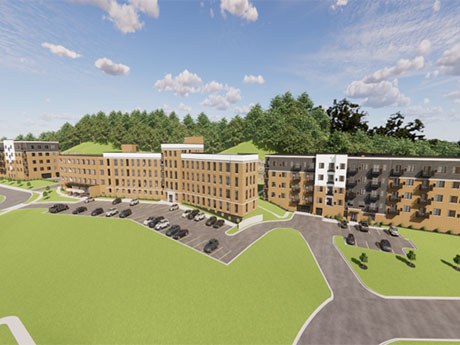Property Assessed Clean Energy (PACE) is a financing tool that provides long-term, low-cost construction financing for new and existing buildings. Some of the eligible improvements include energy efficiency, water efficiency, renewable energy and resiliency measures such as seismic and stormwater measures. For commercial real estate properties, the acronym is listed as C-PACE.
Rafi Golberstein, CEO of Minneapolis-based PACE Loan Group, says there are many reasons why developers like PACE financing today, but the most important is the cheaper cost of capital. REBusinessOnline spoke with Golberstein to learn more about the financing tool and its benefits.

REBusinessOnline: What is driving momentum for PACE financing?
Rafi Golberstein: PACE is effectively solving a hole in the capital stack. In today’s market when banks and mortgage lenders have tightened up significantly, typically lending less and providing less leverage, that creates a pretty large equity check requirement that is significantly larger than it was two years ago. PACE is coming in to help alleviate some of that pressure to allow these projects to still move forward.
In some cases, we’re actually cheaper than the banks. For the developer, it makes a lot of sense to use PACE. There are other structural reasons as well. Bank loans are typically five-year terms; PACE loans we write are typically 25- to 30-year terms with fixed rates and nonrecourse. The bank financing may be fixed or floating and is certainly full recourse. PACE is a significantly more accretive product.
REBO: How do you work to boost awareness of the financing tool?
Golberstein: A lot of it has been education. We started the firm in 2017. At that time, basically no one had heard of PACE before. We spent years educating the market, and it wasn’t just us it was the industry as a whole.
Honestly, COVID was a pretty big pivotal point for PACE in the marketplace because it was the first real blip or adverse change in the market that we had experienced after riding a pretty heavy wave of really aggressive real estate for about 10 years. When COVID hit and suddenly people didn’t know what to do, especially with hospitality assets, everyone was looking for alternative sources of funds because banks said we’re not doing anything. COVID opened the door for people who had heard about PACE but hadn’t really wanted to spend time learning about it. COVID really opened the door for developers and mortgage brokers.
What we found over the past three years is that the mortgage broker industry has finally started to accept PACE and acknowledge it as a real, viable tool in the capital stack. They are increasingly getting requests from their clients to go source PACE. The education and seeing more deals get done has helped.
REBO: What are the qualifications for using a PACE loan?
Golberstein: Our collateral is a special assessment lien, so it is very much akin to a tax lien. I say that because every state has its own tax law, and every state has its own PACE program. The details as far as what qualifies might vary state to state.
Holistically, what we’re looking at is financing properties that have elements of energy-efficiency, renewable energy, water conservation measures or in many states seismic resiliency. We’re funding projects for mechanicals, electricals, plumbing, building envelope budgets, seismic resiliency, roofing, windows and insulation. Anywhere from 20 to 40 percent of your project hard costs are probably PACE-eligible.
I think there’s a misconception out there that because PACE is a clean energy product you have to be doing something unusually expensive or special like a Platinum LEED certification. That’s not the case. Nine out of 10 of our projects qualify for PACE without the need for additional cost burdens if they are building to code. We’re rarely telling clients that in order to qualify they have to go out and spend a lot of money to buy a different HVAC system. That almost never happens.
The other interesting aspect of PACE is that we’re allowed to fund loans retroactively. We refer to it as retroactive PACE. The idea is that if you have a property that would benefit from these eligible improvements, maybe it was new construction or a large renovation, you typically have a three-year window in which to claim your PACE credit. In this market, now that folks are coming off 3 percent interest rate loans into 7 percent interest rate loans, it’s really hard to refinance their debt.
Anything that was built or renovated over the past three years qualifies for retroactive PACE. So we’re coming in as a source of liquidity into these projects. It’s a way to infuse liquidity into projects, negotiate extensions with lenders and get through this current situation that we’re in with the interest rate environment.
A deal we did on a recently renovated Marriott hotel in Northbrook, Illinois, went through that exact scenario. It underwent a major renovation during and right after COVID. It was super expensive to refinance the debt and the owner qualified for a significant amount of PACE financing. We lent the money and the owner used it to help effectuate the paydown of its debt and refinance up.
REBO: Are you seeing PACE used more often for redevelopment/renovations or ground-up construction?
Golberstein: It’s truly both. We pivot to where the market tells us to go. Probably 60 percent of our business is ground-up construction. These days, probably 30 percent is retroactive or rescue capital. The balance is run-of-the-mill replacing HVAC or installing solar panels. Most of what we do today is some form of new construction or recently completed projects.
REBO: What are the benefits for developers using PACE?
Golberstein: There are a lot of structural reasons why developers like the idea of PACE, but the most important, especially in today’s market, is the cheaper cost of capital. A deal we did in Eau Claire, Wisconsin, had that exact scenario. The construction lender was a local Wisconsin bank, and it was charging a spread over prime, which is in the high single-digits. When we came in with an interest rate in the high 7s, we were significantly cheaper than the bank. The developer wanted to use as much PACE and as little bank as possible because that would right size the cost of capital.
Developers can use PACE as a cheaper way to refinance their properties. Because PACE loans typically have 25- to 30-year, fixed-rate, self-amortizing terms, that’s where developers tend to find a lot of the benefit. They’re able to take this and amortize it over a 30-year period. It will ultimately amortize down to zero. At the end of that term, it has been repaid in full. PACE does run with the property. If you are a client of ours and want to sell a property two years later, you don’t have to pay off the PACE loan. The buyer can buy the property subject to that tax assessment.
REBO: Are there some commonalities or themes among the recent deals you’ve completed?
Golberstein: There are two. On the ground-up construction deals, regardless of asset type, we are being used as a way to blend down the cost of capital. Construction debt is really expensive today, and we are cheaper and we’re longer-term with fixed rates and nonrecourse. Thematically, that is where we see PACE being used. The other area we see is retroactive. There is a massive pipeline of deals that cannot refinance out today without a cash infusion. PACE is coming in to serve as that liquidity to help pay down loans. Any property type is in the same boat as far as the increase in interest rates.
REBO: Are there any other misconceptions about C-PACE or facts the industry should be aware of?
Golberstein: PACE is nuanced. It is state by state, and in some cases there are multiple administrators in a given state. But really what’s important is making sure you’re working with the correct PACE lender. It’s crucial because it is really nuanced. You want to make sure you’re working with someone who has a balance sheet and is not just brokering the PACE loan. It’s a surprisingly small world in PACE land. There are very few of us that have balance sheet capacity.
For many years, mortgage brokers thought PACE was difficult and would get in the way of closing a loan. Increasingly, we are getting a lot more calls from mortgage brokers. The best course of action is to get us on the phone with the mortgage lender and explain how PACE works. If you’re open and receptive to do that, it works really well. Once they understand it, that light bulb clicks on.
REBO: What else should our readers know?
Golberstein: People always ask where we get our money from. We do balance sheet our loans. We’re not selling these to third parties at closing. We operate independently, but we are a portfolio company of AB CarVal, which is a subsidiary of AllianceBernstein. We have very significant institutional capital. That is super critical to know that the people you’re working with have the balance sheet to lend on because very few of us do.
PACE is truly a bipartisan product; it works in blue states, red states and purple states. PACE is privately funded dollars from private lenders as a public benefit to developers, but there’s no taxpayer money being deployed anywhere.
— Kristin Harlow
This article originally appeared in the April 2024 issue of Heartland Real Estate Business magazine.


